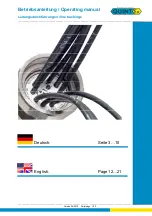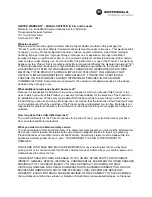
Fault close
1. It is not recommended that operations be made on
known faults.
2. If a fault is experienced, the connector and bushings
must be replaced.
Loadbreak operation
Area must be clear of obstructions or contaminants that
would interfere with this operation.
Secure connector operating eye firmly onto clampstick and
lock.
Thrust clampstick
forward
until the connector moves
approximately 1/4" (5 mm) further onto the bushings. This
action will break any surface friction between outer surfaces
of bushings and inner surfaces of connector interfaces. The
yellow latch indicator rings on the bushings should now be
visible in the cuff windows of the connector.
Looking away from the connector, pull the clampstick and
withdraw the connector from bushings with a fast, firm,
straight motion. Minimum amount of travel of connector to
break load is 9" (230 mm).
Using the clampstick, move the connector away from
the bushings and place the metallic portion of one of the
probes directly onto a ground plane. This will discharge
any capacitive charge that may still be on the probes.
Alternatively, the "C" connecter can be mated directly with
the Cleer standoff bushing to discharge any capacitive
charge that may still be on the probe.
Place an insulated protective cap with ground wire attached
to system ground on the exposed energized bushings using
clampstick.
WARNING
High Voltage. If the fiberglass contact tube of one or
both loadbreak bushing(s) extends forward, the unit
MUST be replaced. Failure to comply could cause
thermal runaway failure or failure to successfully fault-
close; this may result in serious personal injury.
6
CLEER LOADBREAK CONNECTOR SYSTEM INSTALLATION INSTRUCTIONS
MN650019EN March 2016






































